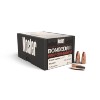Even if you make the case longer, the smaller bore won’t burn powder as efficiently as the larger bore, so you’ll have to add much more barrel length to get the same power out of the smaller diameter case. Even reaching the same kinetic energy, you’ll be giving up the things handgun bullets NEED to do their job, in favor for a few extra rounds in the magazine.
And of course, the long reach grip on the PMR-30, Desert Eagle, etc with long rounds like this is the worst part of the pistol. So you’re working deeper into a hole where you wanted to improve upon the .380, but your bad idea has now made a larger, heavier, less ergonomic pistol, with lesser stopping power. Every step you take on this idea is digging a hole into worse and worse reality... stop digging.
Also recognize, the current market has 1) determined low capacity 380’s are more than sufficient, or 2) a larger pistol in 9mm with a little more grip length for better purchase in hand is an advantage (aka, P365, Glock 48 and 43X, extended LCP/P238/LC9/P938 mag baseplates). Capacity is nice, but grip length is what really turns people off from the pocket 9’s and 380’s.
Look at the 327Fed vs. 357mag. The 327 holds more rounds and nearly matches the energy of the 357. It’s also more expensive, and harder to find. In the case of 327’s, bullets were already available, and tooling for the brass was already on hand, unlike your 6.8 idea. Despite the easier logistical launch 327 is a niche cartridge with little more than a small cult following. But for the same size revolver, the 38spcl and 357mag are better stoppers, and more readily available, less expensive for ammo. The capacity doesn’t mean as much as market availability and stopping power.
Your idea: I want more rounds with the same energy as a 380 (ignoring for a second the reduced stopping power). I created this niche wildcat round which matches the 380’s energy, but yeah, it needs a larger pistol and longer barrel to get there. But hey, the grip is still short, but yeah, it’s also now long and blocky, making the pistol really difficult to hold. But I think everyone should buy this instead of their smaller, lighter 380’s with better stopping power. And buy this instead of the same sized 9mm pistols with better grips and FAR better stopping power, despite the fact the 9mm is the worlds most available, least expensive ammo, and this one has no bullets on the market and worse performance. —> can you not see how EVERY turn you make here is a bad step, both in ballistic performance and product marketability?
I’m an idea man for a living. I come up with ideas and evaluate ideas of others, then determine which products/processes have actual opportunities in the market to decide with investors which we should develop and commercialize. At every turn, this cartridge falls on its face. It’s dead on arrival, and wasting time continuing to hash out details is exactly that - wasting your time.


